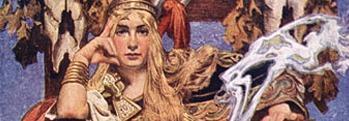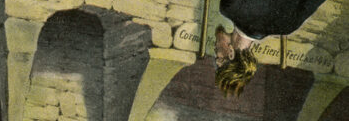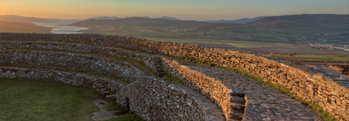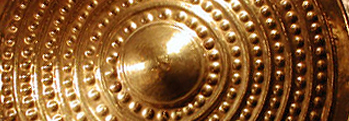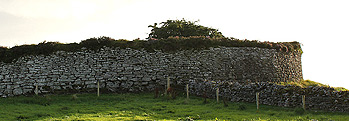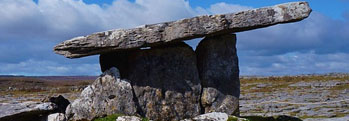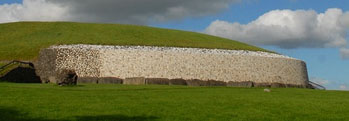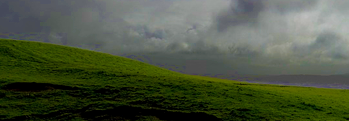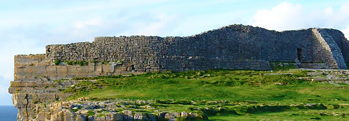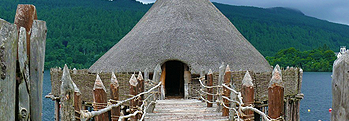Kilcashel Stone Fort
Irish and Celtic myths and legends, Irish folklore and Irish fairy tales and Legendary Places in Ireland
A strong place and a high one
There are tens of thousands of round stone forts in Ireland, some say as many as fifty thousand, if you can believe it, and one of the finest examples we have is at Kilcashel in County Mayo, which comes from the Irish Coill an Chaisil, the woods of the stone fort. Almost perfectly circular in construction, with thick walls two broad men could walk shoulder to shoulder on top of, this would have been a comfortable home for a prosperous farmer or wary lord.
In the Irish tongue they were called ráth or lios if they were made of earth, with the rath being the raised mound and the lios being the open space inside, as some of the larger ones were, and caiseal or cathair if they were made of stone. Dún was a general name for a fortress of any sort.
The exact age of these many ring forts is a matter for dispute among the learned – some say they date from the early medieval, others from the late iron age – the problem you see, is they can find little evidence of any other habitation before these times, although ring forts were built far earlier elsewhere.
As with most such difficulties of course, the answer is simple enough – and it is not that everyone in Ireland lived up trees until the medieval period! Later ring forts were built on top of earlier bronze age ring forts, not only for the ready availability of building materials but these strong constructions were usually situated in a commanding position, at a bend in the river or on top of a high hill with a good view of the surrounding landscape.
And so it is with the beautiful circular stone fort in Kilcashel, which can be found just a little ways to the south and east of Kilmovee. It was likely built, or rebuilt, towards the end of the reign of the mac Colmáins over Connacht, perhaps even in the time of Fergal Aidne mac Artgaile, grandson of the famous Guaire Aidne mac Colmáin.
For they were times of strife and times of war in Ireland back then, and you'd be glad of a good thick stone wall between raiding parties and your family! And thick indeed are the walls of Kilcashel stone fort, a full five meters at the base, and three meters in height, protecting an area thirty meters across. It is easy to imagine a whole clan gathered around the fire within, listening to the tales of their ancestors and playing Fidcheall.
Not only that but there are a couple of secret passageways in the walls which the bold can still enter today, and perhaps they were used at the time to hide valuables, or even people!
It was one of three stone ring forts that stood in the area, all of them atop a long sandstone ridge that offered broad views over the rolling countryside and pastures. Sadly, two of them were destroyed only recently, but the last is as good a specimen as you could wish for.
When you enter the stone fort, you can immediately see four sets of steps leading up to the top of the wall, although some of the steps are a bit loose these days, and the two creep-ways which bring you to a hidden chamber inside the walls. There is also a collapsed tunnel entrance which is called a souterrain, and a couple of collapsed houses, as well as a tree who has declared himself the new master of the fort.
Close to Kilcashel stone fort can be found dozens of important ancient sites, the whole area is steeped in magnificent ancient Irish history. Raherolus, or in Irish Ráth Fhireolais, which means the fort of the men of learning, is the name of the next townland, and local tales tell it was meant to have been an important centre of learning once. There is a fulachta fiadh from the bronze age, which is an ancient cooking site signified by burned stones, and even a bullán, which is a kind of stone bowl filled with water, often of mystical significance.
Kilcashel stone fort can be found on the map below!
Legendary Places in Ireland
The gift of the gab, as it’s known, is a common thing among the Irish – being able to talk all day about anything and everything, and do it in a way that would have you listen as well. It’s as Irish as red hair and freckles. But what if you didn’t have the gift of the gab, or felt a deficiency of gabbiness? Never fear, al ... [more]
Ireland is a land of many treasures – some are well known while others are known only to a few, like the mysterious stone circles of Beaghmore! In the north of County Tyrone they can be found, at the edge of the Sperrin mountains looking out over the wide countryside below, dating back to the bronze age and earlier, to the time when the Tuath ... [more]
The royal ringfort of Grianán Ailigh was known as the father of every building in Ireland by the Annals of the Four Masters, who also claimed it was first built in the year 1500 BC, in the time of the Tuatha Dé Danann! A mighty place of strength it is and was and may always be, one of the few locations in Ireland correctly marked on a ... [more]
Knockma of the mists is a place wreathed in secrets and myth where they say sleeps the greatest king of the Sidhe, he whose name was Finnbheara! Should you go for a walk around Knockma Hill, pay close attention to that which you cannot see – a warm breeze meant a good fairy was passing by, and a sudden shiver meant an evil one was close! J ... [more]
Nine is a mystical number in Irish folklore, being thrice three, itself known from ancient times as a mysterious symbol, and so should you happen across nine stones, you would do well to be extra careful! For who knows what might lie sleeping just below the surface. And such a place can be found on the saddle between Sliabh Bán, the White ... [more]
Once upon a time there were many kingdoms in Ireland, and many kings, or perhaps they would have been better known as chieftains, but kings they were for all that. As time went by each of these kingdoms fell and were joined one into the other, but yet a single kingdom still remains in the farthest north and farthest west of the country, and this is ... [more]
Ireland's bones are made of stories, you can hardly step over a rock or walk past an old mound but if it could speak, it would tell you tales you could hardly imagine. But of all the legended glens and fields misty with memory in this ancient nation, there are few with as many secrets hidden in their depths as Lough Gur in county Limerick. S ... [more]
There are tens of thousands of round stone forts in Ireland, some say as many as fifty thousand, if you can believe it, and one of the finest examples we have is at Kilcashel in County Mayo, which comes from the Irish Coill an Chaisil, the woods of the stone fort. Almost perfectly circular in construction, with thick walls two broad men could walk ... [more]
Scattered throughout the Irish countryside are hundreds if not thousands of holy wells, almost all of great antiquity, even predating Christianity. They can take almost any form and show up in any place, shimmering in the shadow of engraved stone monuments, in lapping sea caves where the fresh and salt waters mingle twice a day, as natural springs ... [more]
In county Roscommon there's a place of great antiquity called Oweynagat, which some have mistakenly thought to mean the Cave of Cats, although it has nothing to do with cats - “cath” being the Irish word for “battle” and so it should rightfully be called the battle cave. Indeed it has a long association with the Morrigan ... [more]
The Burren is one of the wonders of Ireland. A rolling rocky landscape of limestone hills and plains, it is marked with history stretching back thousands of years. Nestled in between the limestone slabs are herbs and plants you'd be hard pressed to find elsewhere, hailing from places as far afield as the Arctic and the Mediterranean, kept warm ... [more]
Older than Stonehenge and the great pyramids of Giza stands Newgrange, the heart of legends and mysteries stretching back five thousand years. Situated along the river Boyne near to numerous other such places like Knowth and Dowth, that very same river where Fionn Mac Cumhaill was said to have first found and tasted the salmon of knowledge, and the ... [more]
The seat of the High Kings of Ireland of old, Tara or Temair as it was known then, is said to have been the seat of a hundred and forty two kings, kingships won by battle, contest and merit, not passed down father to son as in more primitive cultures. One of the most important monuments in the sacred Boyne valley, its history stretches back four th ... [more]
Dun Aengus means "the Fort of Aenghus", and remains one of the most impressive ancient monuments in Ireland, Europe or the world. Perched on the edge of a high and jagged cliff with the grey-green waters of the Atlantic battering below, it gained its name from its original builders, who were called the Fir Bolg, some of the first to arriv ... [more]
Crannogs, the name meaning "young trees" for reasons which aren't too clear, were dwelling places for people in Ireland from the time of the Tuatha de Dannan right up to the seventeenth century. They were built on shallow lakes or pools on top of tree trunks stuck into the lake bottom, piles of rocks, mud and other debris or on natura ... [more]
Croagh Patrick or Patrick's Stack is an important place of pilgrimage for Christians throughout Ireland and the world today, some even walking the ascent in their bare feet as penance for their sins. However it was considered a holy place long before St Patrick came to visit, even though it is said he banished the snakes from Ireland while stan ... [more]
Rising from the ocean a short distance off the coast of county Kerry in southern Ireland, Skellig Michael and its smaller brother rear up out of the Atlantic ocean like jagged grey teeth. Famous poet George Bernard Shaw who visited the place in 1910, called it an "incredible, impossible, mad place" and "part of our dream world". ... [more]












